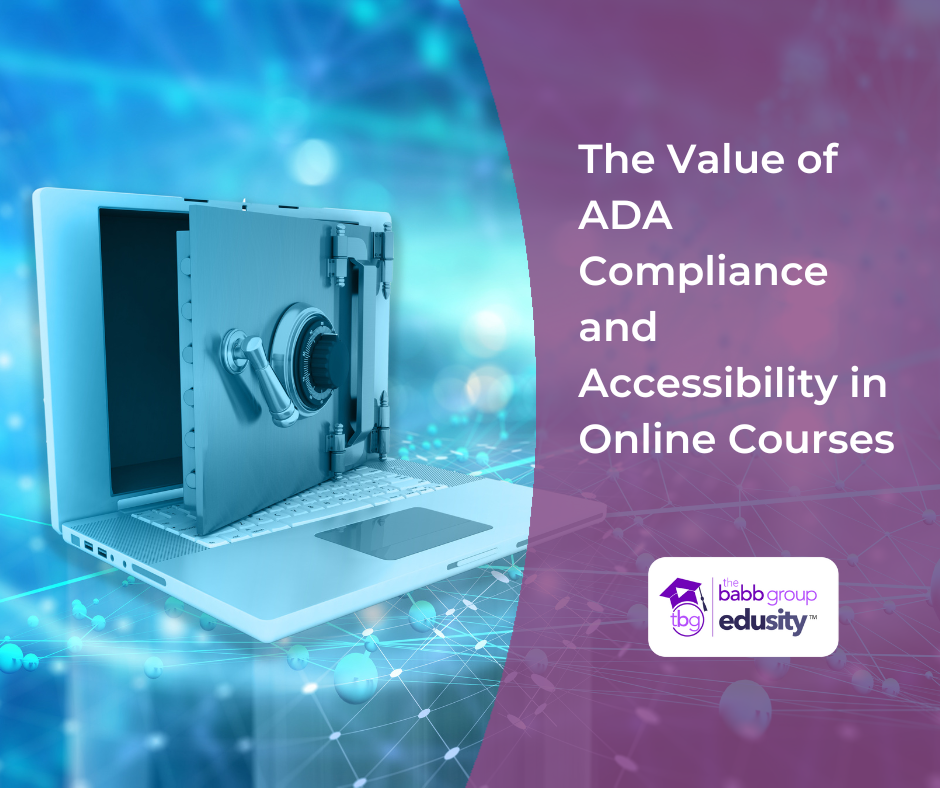Whether creating a course online or performing maintenance on an existing course, now is the time to review for accessibility. Accessibility for individuals with disabilities is required by the U.S. Department of Education. More students are demanding equal access in their online and in-person classrooms.
You might also like Proactive Planning for Safe and Accessible Online Learning Environments.
Accessibility starts with instructional design and planning for how to use tools in a student-focused manner. It’s essential to remove barriers to learning for all students. This can involve software, screen-reader compatible fonts, suitable contrast levels, atl text versions of images or image descriptions, captioning, headings, table adjustments, and overall accessibility of non-HTML content.
Get a professional ADA compliance and accessibility review.
Fry notes that college administrators must recognize the significance of ADA compliance and accessibility in ensuring an inclusive learning environment. She says, “Accessibility promotes inclusion of all learners, increases engagement and participation, and fosters a sense of belonging. Incorporating accessibility into online learning also helps eliminate unfair barriers to learning based on physical or cognitive abilities. By investing in accessibility, we can create learning opportunities for everyone.” By embracing Universal Design for Learning (UDL) principles and adhering to ADA guidelines, schools can meet legal requirements and provide equal educational opportunities for all students. Let’s dive into the value and benefits of prioritizing ADA compliance and accessibility in online courses.
What is ADA Compliance and Accessibility?
ADA compliance refers to conforming to the regulations outlined in the Americans with Disabilities Act, which ensures equal access to educational resources and services for individuals with disabilities. Accessibility focuses on designing online courses and platforms to accommodate diverse learning styles and needs.
Universal Design for Learning (UDL)
UDL is an educational framework that promotes accessible and inclusive learning experiences for all students. It emphasizes providing multiple means of representation, engagement, and expression to accommodate diverse learning preferences and abilities. Incorporating UDL principles into online course design can significantly enhance the learning experience and accessibility.
Legal Obligations and Ethical Responsibilities
Colleges and universities are legally obligated to comply with ADA regulations, including online courses and digital materials. By ensuring ADA compliance, institutions protect themselves from potential legal issues, such as discrimination lawsuits. Moreover, prioritizing accessibility reflects an institution’s commitment to fostering an inclusive and equitable learning environment.
Improved Learning Experience
When online courses are designed with ADA compliance and accessibility in mind, they benefit all students, not just those with disabilities. Accessible course materials, such as captioned videos, alternative text for images, and consistent course design and navigation, enhance comprehension and engagement for all learners. By catering to various learning preferences and abilities, institutions can improve student satisfaction, retention rates, and overall academic success.
Expanded Reach and Diverse Student Enrollment
Creating ADA-compliant and accessible online courses encourages recruitment and retention as schools appeal to a broader range of students. By eliminating barriers to access, institutions can attract and retain students who may have otherwise faced challenges in traditional classroom settings. This commitment to inclusivity can also help institutions meet diversity and equity goals.
College administrators must prioritize ADA compliance and accessibility when designing and delivering online courses. By incorporating UDL principles and adhering to ADA guidelines, institutions can create inclusive learning environments that benefit all students. This commitment meets legal obligations and fosters student success, expands enrollment, and demonstrates a dedication to equity and inclusivity. Embracing the value of ADA compliance and accessibility is a win-win for institutions and students in the evolving landscape of higher education.
Unsure where to start with making your courses and programs ADA-compliant and accessible? Talk to The Babb Group’s experts today.
Angela Britcher
Latest posts by Angela Britcher (see all)
- Enhancing First-Year Experiences in Higher Education - August 1, 2024
- Enhancing Education with Virtual Reality: A Hands-On Approach - June 27, 2024
- Higher Education Trends: Insights from Our COO, Sheila Fry - June 13, 2024
